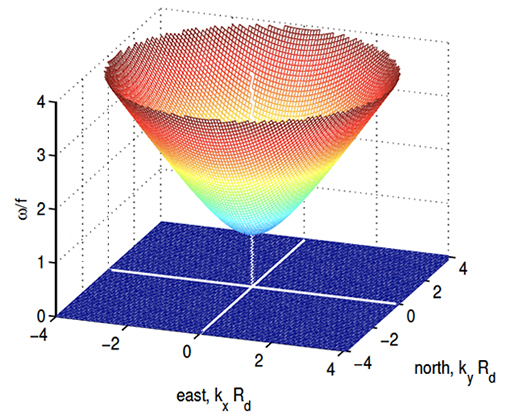
This online textbook is an introduction to rotating reference frames and to the effects of Earth’s rotation on the large-scale flows of the atmosphere and ocean. It is intended for students who are beginning a quantitative study of Earth science and geophysical fluid dynamics and who have some background in classical mechanics and applied mathematics. It includes the following 5 parts.
Part 1. The Coriolis Force, Inertial, and Geostrophic Motion: This part is intended for students who are beginning a quantitative study of geophysical fluid dynamics and who have some background in classical mechanics and applied mathematics.
Part 2. A Rotating Shallow Water Model, Potential Vorticity Balance, and Geostrophic Adjustment: The goal and plan of this part is to develop further insight into the consequences of the Coriolis force by analyzing a sequence of experiments in which a thickness anomaly of horizontal scale \(L\) is released from rest and allowed to evolve under the influence of gravity and the Coriolis force. These geostrophic adjustment experiments are posed in a single-layer fluid model, often called the shallow water model.
Part 3. Beta Effects and Westward Propagation: The goal of this part is to understand some of the very important beta effects (\(\beta\)-effects) that follow from the northward increase of the Coriolis parameter, \(f\), in linear approximation, \(f = f_o +\beta y\).
Part 4. Wind-Driven Ocean Circulation and the Sverdrup Relation: This part seeks to develop insight for several major features of the observed, upper ocean circulation, e.g., western intensification of the major gyres and the geography of seasonal variability. A key element in this is understanding Sverdrup relation between meridional transport and the wind stress curl. To see how Sverdrup flow arises, shallow water models are solved for the circulation of a model ocean that is started from rest and driven by a specified wind stress: westerlies at mid-latitudes and easterlies in subpolar and tropical regions. This gives three regions of stress curl, negative over the subtropics, and positive over subpolar and tropical regions.
Part 5. On the Seasonally Varying Circulation of the Arabian Sea: The object here is to offer a concise description of some of the remarkable phenomena that make up the Arabian Sea circulation both winter and summer. The specific goal is to explain as simply as possible the link between the wind and the vigorous summertime circulation.
Online Textbook
Part 1: The Coriolis Force, Inertial, and Geostrophic Motion (PDF)
Part 3: Beta Effects and Westward Propagation (PDF)
Part 4: Wind-Driven Ocean Circulation and the Sverdrup Relation (PDF)
Part 5: On the Seasonally Varying Circulation of the Arabian Sea (PDF)








